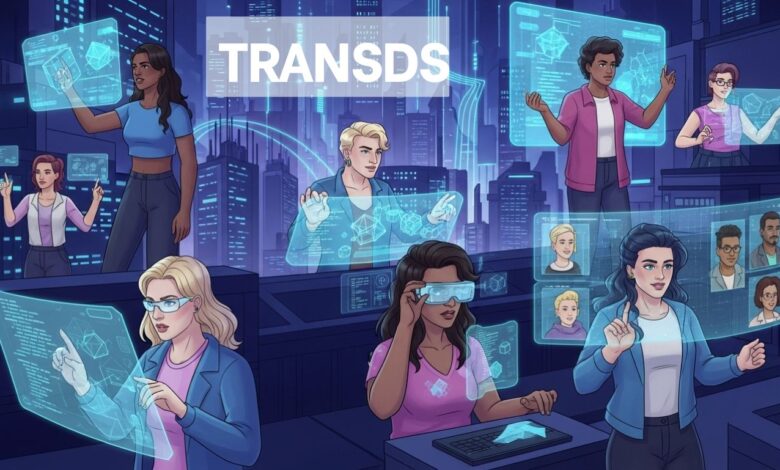Future of Transds: How They Are Shaping Digital Landscapes

In the bustling digital landscape, where content is king and attention spans are fleeting, transitional devices—commonly known as transds—play a crucial role in guiding readers through the maze of information. They act like signposts along a winding path, ensuring that every thought flows seamlessly into the next. As we dive deeper into this essential component of writing, it becomes clear just how much they influence comprehension and engagement.
Whether you’re crafting an article, weaving together narratives for social media, or designing interactive web experiences, understanding transds will elevate your content creation game. These powerful tools not only make text more coherent but also enhance user experience across various digital platforms. Join us on this journey to explore the significance of transds and discover how they shape our increasingly interconnected world.
What is Transds?
Transds, short for transitional devices, are essential tools in writing. They help bridge gaps between ideas and ensure a seamless flow throughout the text. Think of them as signposts that guide readers through your narrative.
These devices can take many forms: words, phrases, or even sentences. Examples include “however,” “on the other hand,” and “for instance.” Each plays a unique role in connecting thoughts.
Using transds effectively enhances clarity. They clarify relationships among concepts while maintaining engagement with the audience. Without these devices, writing may appear disjointed or confusing.
In an age where digital content reigns supreme, mastering transds becomes increasingly vital. As writers adapt to various formats—from blogs to social media posts—understanding how to employ transitions skillfully can elevate any piece of content significantly.
Importance of Transds in Creating Coherence and Flow in Writing
Transds play a crucial role in writing by creating coherence and enhancing flow. They act as signposts, guiding readers through the text. This guidance helps maintain clarity, allowing ideas to connect seamlessly.
When used effectively, transds can bridge thoughts and concepts. Instead of jarring transitions, they provide a smooth reading experience that keeps audiences engaged. A well-placed transitional device can turn disjointed sentences into a cohesive narrative.
In digital content, where attention spans are short, these devices become even more essential. Readers appreciate clear pathways between points; it reduces confusion and enhances comprehension.
Employing varied types of transds not only enriches the writing but also invites readers to explore further without losing their way. It’s about crafting an enjoyable journey through information while ensuring each idea builds on the last.
Current Trends and Usage of Transds in Digital Content
Transds are evolving in the digital content landscape, significantly shaping how information is presented. Content creators increasingly incorporate transitional devices to enhance readability and engagement.
Currently, there’s a noticeable shift towards using visual transds like infographics and interactive elements. These tools not only guide readers but also break up dense text, making complex ideas more digestible.
Another trend is the integration of multimedia transitions within videos and podcasts. Creators use sound cues or animated graphics to signal shifts between topics seamlessly. This approach keeps audiences engaged while enhancing comprehension.
Social media platforms are also seeing an uptick in transds usage. Captivating captions and hashtags serve as effective transitional phrases that connect posts with broader conversations.
As digital content continues to evolve, so does the application of transds. The focus remains on maintaining clarity while enriching user experience through innovative techniques.
Impact of Transds on User Experience and Engagement
Transds play a crucial role in enhancing user experience across digital platforms. By providing seamless transitions between ideas, they guide readers through content effortlessly. This flow keeps users engaged and minimizes the risk of losing their attention.
When users encounter well-placed transds, it feels like navigating a well-marked path. They can follow along without getting lost in dense information or convoluted arguments. Clear connections lead to better comprehension and retention of material.
Moreover, effective use of transds encourages interaction with content. It invites readers to explore related sections rather than simply skimming for key points. As users dive deeper into topics, their overall engagement increases.
In an era where attention spans are short, utilizing transds effectively is more important than ever. They create a cohesive narrative that resonates with audiences, making complex ideas accessible and enjoyable to read.
Challenges and Limitations of Using Transds
Despite their usefulness, transds come with challenges that writers must navigate. One prominent issue is overuse. When too many transitional devices are applied, they can clutter the text and detract from its clarity.
Additionally, some readers may find certain transitions confusing or awkward. A poorly chosen transd can disrupt the flow rather than enhance it, leading to frustration.
Cultural differences also play a role in how transds are perceived. What works seamlessly in one language might not translate effectively into another due to varying writing conventions.
There’s the risk of redundancy. If multiple sentences employ similar transitions, they can create an unintentional monotony that disengages readers—making it crucial for writers to vary their approach while maintaining coherence.
The Evolution of Transds: From Text to Multimedia Formats
The concept of transds has evolved significantly over the years. Initially, they served as simple connectors in text—bridging ideas and enhancing clarity. They were mainly confined to written language, helping readers navigate through arguments smoothly.
As technology advanced, so did the application of transds. Today, we see them in multimedia formats that enrich digital content. These devices can now be visual elements like infographics or interactive graphics that guide users from one point to another.
Video transitions also serve as effective transds in storytelling, maintaining coherence while engaging audiences visually and audibly. This shift reflects our changing consumption habits; people crave dynamic experiences rather than static ones.
With platforms prioritizing user engagement more than ever before, the future promises even more innovative uses for transds across various media types.
Predictions for the Future of Transds in Digital Landscapes
As digital content continues to evolve, the role of transds will become increasingly sophisticated. We can expect these transitional devices to adapt seamlessly across various platforms. Enhanced by AI and machine learning, they will offer more personalized experiences for users.
Visual and auditory elements might integrate with traditional text-based transitions. Imagine a video that not only guides viewers through its narrative but also uses visual cues as effective transds.
Furthermore, as interactive content becomes commonplace, the demand for innovative will rise. Users may interact with them in real-time, leading to richer engagement levels.
Transds could also play a crucial role in accessibility features. They might help bridge gaps for individuals with different needs or preferences by providing multiple ways to understand context and flow.
With technological advancements on the horizon, there’s no telling how creative and dynamic future applications of transds will be in shaping user experience online.
Embracing the Power of Transds
Transds hold immense potential in shaping the way we communicate. By seamlessly guiding readers through content, they enhance understanding and retention.
Incorporating is not just about linking ideas; it’s about creating a narrative flow. This fosters deeper connections with audiences, making them feel more engaged.
As digital landscapes evolve, so does the role of. They can adapt to new formats—whether text, video, or interactive media—ensuring that coherence remains at the forefront.
Embracing these devices means prioritizing clarity and engagement in communication strategies. Brands and creators who harness this power are better equipped to capture attention in an increasingly crowded space.
By integrating transds effectively into their work, writers can elevate their message while providing a richer experience for users navigating complex information. The future of storytelling lies in our ability to embrace these tools fully.
Conclusion
The world of digital content is ever-evolving, and the role of transds has never been more critical. As we navigate through vast amounts of information daily, transitional devices are essential in creating coherence and flow in writing. They guide readers seamlessly from one idea to another, enhancing readability.
As technology advances, the use of is likely to expand beyond traditional text formats. We may see an integration with multimedia elements that enrich user experience even further. The challenge will be balancing innovation with clarity to ensure that communication remains effective.
Transds have already started shaping how users interact with content online. Their impact on engagement cannot be overlooked; they hold power over how easily audiences can digest material.
Looking ahead, it’s clear that embracing these tools will continue to enhance storytelling across various platforms._ As writers and creators explore new ways to engage their audiences, transds will remain a vital component in crafting meaningful connections through words.



